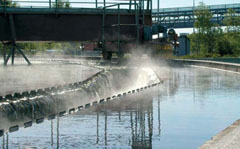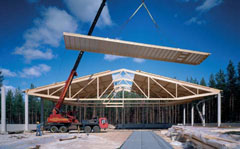Condition monitoring
The main research goal is to develop advanced condition monitoring methods of mechatronic systems. Condition monitoring methods of mechatronic components e.g. in fluid power systems are very often unsuccessful. This is usually a result of too little measured data of the machine and especially of the component. A second reason is that the behaviour of the mechatronic components changes a lot during the life cycle.
A new approach of using measured data of other machine processes to find out the condition changes will be utilized. For instance, in a paper mill useful data is collected from various automation systems, through product quality control and in the future also from energy consumption levels. Combining this information in “virtual sensors” and comparing it with computer models of the system will provide new condition control methods for the future machines.
The task will be conducted through the steps of (1) defining the indicative methods for condition monitoring through other machine processes and changes in energy consumption levels, (2) developing methods and algorithms for sensor fusion to fully utilise the multisensor systems of paper machine processes, (3) simulating and analysing condition monitoring and runnability and (4) developing control methods to optimise system performance despite changes in the condition of mechatronic components. The deliverables from the task are sensor fusion methods and algorithms for condition monitoring of adaptive control system.
New paper machine concepts
In raising the production capacity of paper machines, the predominant trend in machine technology has been towards higher running speeds. The most recently delivered commercial paper machines are designed for a running speed of 2000 m/min, whereas pilot paper machines are running at over 2500 m/min. Some pilot machines have been running even faster; for example a pilot coating machine has made a speed record of over 3100 m/min. Compared to pilot machines, a commercial paper machine has longer rolls, which results in a reduced natural frequency and therefore difficulties in controlling paper machine vibrations. Consequently, with a cylindrical shell of constant thickness, the mass of the roll is increased and shell stiffness is reduced. At the same time, the paper produced must have a higher and more even quality, which means uniform cross and machine direction profiles. For printing papers, the main end-use properties and quality components are runnability, printability and print quality.
The main research goal is to create methods and tools to design and build an ultra high-speed paper machine. The result of this new concept will be a less expensive paper machine with a substantially lighter frame structure and smaller rolls. As a consequence, most of the rolls will be running above critical speed. The machine can produce paper with reduced consumption of raw materials and energy.
The aspiration for higher speeds will also create new and yet unchallenged problems. Challenges in machine dynamics will require research efforts to examine vibration and noise issues, where both active and semi-active control methods will be studied.
The sub areas of the task are (1) machine dynamics and methods for vibration control, (2) methods and tools for balancing supercritical rolls at operating conditions, (3) active vibration and roll geometry control in running conditions (including semi-active methods) and (4) methods to reduce vibration excitation. The tasks will lead to verified mathematical models and methods to control the dynamic behaviour of ultra high-speed paper machine rotors. | 





